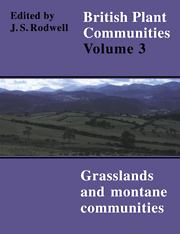Book contents
- Frontmatter
- Contents
- List of Figures
- Preface and Acknowledgements
- Preamble
- Mesotrophic Grasslands
- Community Descriptions
- Calcicolous Grasslands
- Community Descriptions
- Calcifugous Grasslands and Montane Communities
- Community Descriptions
- Index of Synonyms to Grasslands and Montane Communities
- Index of Species in Grasslands and Montane Communities
- Bibliography
U1 - Festuca Ovina-Agrostis Capillaris-Rumex Acetosella Grassland
Published online by Cambridge University Press: 04 July 2020
- Frontmatter
- Contents
- List of Figures
- Preface and Acknowledgements
- Preamble
- Mesotrophic Grasslands
- Community Descriptions
- Calcicolous Grasslands
- Community Descriptions
- Calcifugous Grasslands and Montane Communities
- Community Descriptions
- Index of Synonyms to Grasslands and Montane Communities
- Index of Species in Grasslands and Montane Communities
- Bibliography
Summary
Synonymy
Graminetum arenosum Tansley 1911 p.p.; Grass heath association Tansley 1911, Farrow 1915; Festuco-Agrostidetum Watt 1936 p.p.; Grass-heath Tansley 1939p.p.; Breckland Grasslands D-G Watt 1940; Aira praecox-Teesdalia nudicaulis vegetation Jarvis 1974.
Constant species
Agrostis capillaris, Festuca ovina, Rumex acetosella.
Rare species
Astragalus danicus, Crassula tillaea, Dianthus deltoides, Lychnis viscaria, Scleranthus perennis, Silene conica, S. otites, Thymus serpyllum ssp. serpyllum, Veronica spicata.
Physiognomy
The Festuca ovina-Agrostis capillaris-Rumex acetosella grassland is a very diverse but highly distinctive vegetation type, with an open sward of small tussocky grasses, among which there can be an abundance of dicotyledons, many of them diminutive ephemerals, and sometimes an extensive cover of lichens and/or mosses. Of the grasses, Festuca ovina (only very locally replaced by F. rubra) and Agrostis capillaris are the most frequently encountered and abundant overall, though their total cover and proportions in individual stands are very variable. A. capillaris is the more sporadic and it certainly seems less universally prominent now than in the days of long-continued and heavy grazing by rabbits, an influence of very great importance when the most renowned stands of the community were first described from Breckland (Farrow 1915, Watt 1940, 1960a). A. stolonifera and A. canina ssp. montana have also been recorded less often than seems to have been the case in some areas prior to myxomatosis: then they could be common and sometimes abundant, whereas now they are usually no more than occasional.
Other perennial grasses are generally of limited importance in the community. Koeleria macrantha is the most widely distributed overall, though it is never more than moderately frequent and is always of low cover, its relative scarcity here contrasting with its common occurrence in the Festuca-Hieracium-Thymus grassland, the community which, in this scheme, includes the more calcicolous of the swards grouped together among the Breckland ‘grass-heaths’ of the classic accounts (Tansley 1911, Farrow 1915, Watt 1940). In other stands included here, where the Festuca-Agrostis-Rumex grassland extends a little way on to less parched soils, Anthoxanthum odoratum can be found, together with occasional Holcus lanatus, though neither of these plays the important role that they assume among Nardo-Galion swards in north-western Britain.
- Type
- Chapter
- Information
- British Plant Communities , pp. 300 - 316Publisher: Cambridge University PressPrint publication year: 1992

